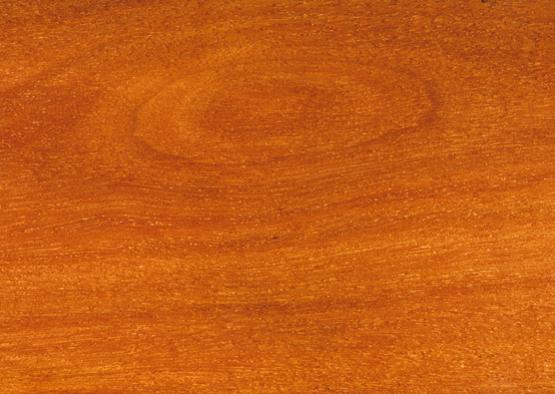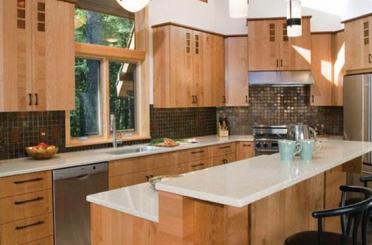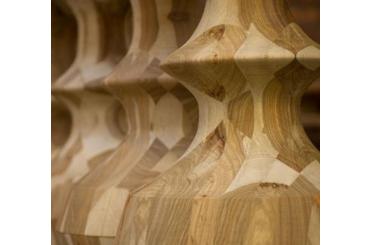American black walnut is a premium cabinet and furniture making timber, native to the eastern regions of North America. Availability in Australia is generally limited to the upper grades.
American Walnut, Black Walnut, Virginia Walnut, Canaletto, Black Hickory Nut
Juglans nigra

American black walnut is a medium to large hardwood, native to the eastern regions of North America. Its heartwood ranges from a golden to rich chocolate brown colour, sometimes with narrow streaks of a darker purplish-brown. Sapwood is a distinctive creamy white colour. American black walnut is a fine and generally straight-grained timber, although sometimes it has an attractive wavy or curly grain, giving it a highly decorative figure.
By virtue of its appearance, durability and ready workability - being only moderately hard - American black walnut is an excellent cabinetmaking timber. It performs well with both machine and hand tools and can be polished to a high finish. It is also an excellent timber for carving and turning and is suitable for steam bending. It glues satisfactorily if conditions are carefully controlled. It is suited to high-end cabinetwork, and is a timber of choice for gunstocks. Other applications include general furniture and joinery work.
In Australia, commercial availability of American black walnut timber products is generally limited to the upper grades, in which knots and sapwood commonly occur. It is most readily available in Australia as a veneer.
Shrinkage
| Very Low | Low | Medium | High | Very High | |
|---|---|---|---|---|---|

|

|

|
|||
Tangential : |
4.90%
|
||||
Radial : |
3.40%
|
||||
Unit Movement Tangential: |
0.27%
|
||||
Unit Movement Radial: |
0.19%
|
Strength Group

Very High |
High |
Reasonably High |
Medium High |
Medium |
Reasonably Low |
Low |
Very Low |
||
Unseasoned: |
S1 |
S2 |
S3 |
S4 |
S5 |
S6 |
S7 |
S8 |
|
|---|---|---|---|---|---|---|---|---|---|
 |
|||||||||
Seasoned: |
SD1 |
SD2 |
SD3 |
SD4 |
SD5 |
SD6 |
SD7 |
SD8 |
|
 |
Stress Grade

| Structural No. 1 |
Structural No. 2 |
Structural No. 3 |
Structural No. 4 |
Structural No. 5 |
|
Unseasoned: |
F11 |
F8 |
F7 |
F5 |
F4 |
Seasoned: |
F17 |
F14 |
F11 |
F8 |
F7 |
Density per Standard

Seasoned: |
615kg/m3
|
|---|---|
Unseasoned: |
970kg/m3
|
Joint Group

Very High |
High |
Reasonably High |
Medium |
Low |
Very Low |
|
Unseasoned: |
J1 |
J2 |
J3 |
J4 |
J5 |
J6 |
|---|---|---|---|---|---|---|
 |
||||||
Seasoned: |
JD1 |
JD2 |
JD3 |
JD4 |
JD5 |
JD6 |
 |
Colour

| White, yellow, pale straw to light brown | Pink to pink brown | Light to dark red | Brown, chocolate, mottled or streaky | |
 |
||||
Mechanical Properties
Modulus of Rupture - Unseasoned: |
66
|
|---|---|
Modulus of Rupture - Seasoned: |
101
|
Modulus of Elasticity - Unseasoned: |
9.8
|
Modulus of Elasticity - Seasoned: |
11.6
|
Maximum Crushing Strength - Unseasoned:  |
29.6
|
Maximum Crushing Strength - Seasoned: |
52.3
|
Impact - Unseasoned: |
|
Impact - Seasoned: |
|
Toughness - Unseasoned: |
|
Toughness - Seasoned: |
|
Hardness - Unseasoned: |
4
|
Hardness - Seasoned: |
4.5
|
Durability
| Low | Moderate | Reasonably High | High | |
| (0 - 5 yrs) | (5 - 15 yrs) | (15 - 25 yrs) | (more than 25 yrs) | |
In-Ground: |
 |
|||
| (0 - 7 yrs) | (7 - 15 yrs) | (15 - 40 yrs) | (More than 40 yrs) | |
Above ground: |
 |
|||
| (0 - 20 yrs, usually < 5) | (21 - 40 yrs) | (41 - 64 yrs) | (More than 60 yrs) | |
Marine Borer Resistance: |
Lyctid Borer Susceptibility: |
Susceptible |
|---|---|
Lyctid Borer Susceptibility - Other: |
|
Termite Resistance: |
Not Resistant
|
Fire Properties
| 1 - non-combustible | 2 - reasonably non-combustible | 3 - slightly combustible | 4 - combustible | |
Fire Properties Group |
Average Specific Extinction Area: |
<250
|
|---|---|
Bushfire Resistance: |
Not Tested
|
American black walnut heartwood ranges from light to dark chocolate brown in colour, sometimes with narrow streaks with a purplish or darker brown tone. In comparison, sapwood is a distinctive creamy white. Black walnut is a finely grained timber, often with attractive swirls and wave patterning, especially around knotty areas. The heartwood lightens in colour as it ages, especially when it is exposed to UV light.
American black walnut is an exceptional cabinet and furniture making timber due to its attractive appearance. The timber is also used for doors, flooring, joinery, mouldings and turnings. In Australia, black walnut is typically available as a veneer and used for paneling and cabinetry.
American black walnut performs well with both machine and hand tools, and takes a very high polish. It is an excellent timber for carving and turning and is suitable for steam bending. It glues satisfactorily if conditions are carefully controlled. Black walnut also has good dimensional stability.
Allied Forest Products
Austim Pty Ltd
Australian Timber

Briggs Veneers Pty Ltd

Creative Timber World

Garde Timber Pty Ltd

GreeniGo
M1 Timber Works Pty Ltd

Market Timbers




